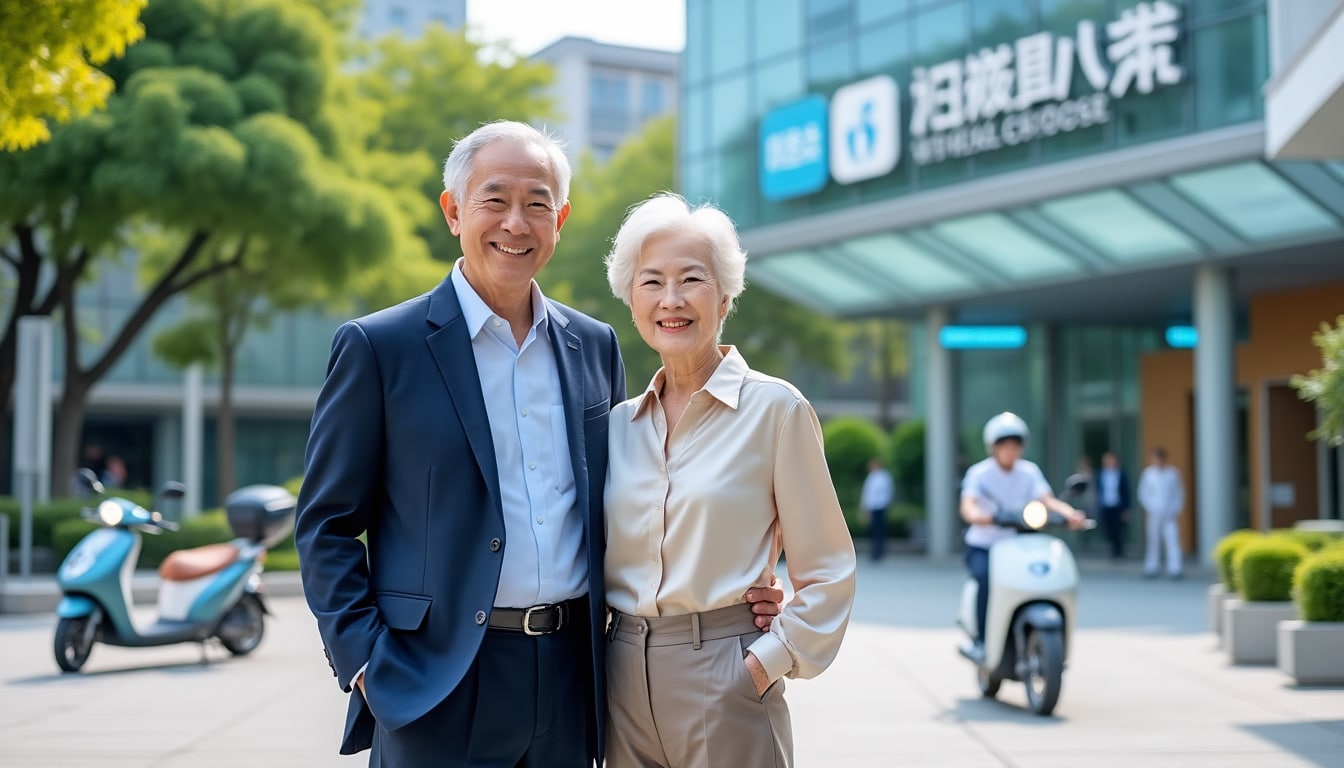Welcome to our platform. Your privacy is at the core of our priorities. Discover how we use cookies and data to enhance your experience.
We use cookies and data to provide and maintain our services, monitor interruptions, and protect ourselves against spam, fraud, and abuse. We also evaluate audience engagement and site statistics to understand the usage of our services and improve their quality. By accepting all cookies, we can develop new services, measure the effectiveness of our advertisements, and display personalized content and ads according to your settings.

With a constantly increasing aging population, China is positioning itself as a pioneer in developing an innovative senior economy. This proactive approach aims to meet the specific needs of older adults while stimulating economic growth. Let’s explore how innovation intertwines with demographics to shape a harmonious and prosperous future.
How does the senior economy influence the Chinese market?
The senior economy in China represents a huge opportunity, fueled by the rapid aging of the population. According to the IMF, the Argentine economy also shows promising prospects in the face of this demographic challenge, highlighting a global trend where aging countries can transform their societies and economies. In China, this transition manifests through a diversification of services and products tailored to the needs of the elderly.
The aging population stimulates the creation of new markets, particularly in the sectors of health, leisure, and technology. Innovative companies are developing specific solutions, such as advanced medical devices, health monitoring applications, and teleassistance services. Furthermore, the insurance market in Hong Kong, for example, could explode by 55% due to the aging of the Greater Bay Area, illustrating the scope of this transformation.
This evolution is not limited to the private sector. Local and national governments are also investing in suitable infrastructures, thereby fostering an environment conducive to senior growth. Initiatives aimed at improving accessibility, security, and quality of life are being implemented, strengthening the integration of older individuals into society.
To learn more about the economic prospects related to aging, check out this article on the Argentine economy.
What technological innovations support the senior economy in China?
Technological innovation plays a central role in the development of the senior economy in China. Advances in artificial intelligence, robotics, and the Internet of Things (IoT) are particularly relevant for improving the daily lives of older adults. These technologies allow for the creation of personalized solutions that address the specific needs of seniors while promoting their autonomy and well-being.
For example, assistance robots are increasingly being used to help seniors with their daily tasks, providing physical and emotional support. Connected health applications facilitate real-time monitoring of vital parameters, thereby enabling early detection of health issues and management of chronic diseases.
Moreover, teleassistance platforms and teleconsultation services are becoming essential, especially in rural areas where access to care may be limited. These technological innovations not only improve the quality of life for seniors but also create new economic opportunities in the tech sector.
To explore how the aging population is stimulating a new flourishing sector in China, visit this detailed article.
What are the challenges of integrating seniors into the Chinese economy?
Despite the numerous opportunities, the integration of seniors into the Chinese economy also presents significant challenges. One of the main obstacles is the adaptation of existing infrastructures to meet the specific needs of older adults. This includes the creation of suitable housing, improving accessibility in public places, and developing more user-friendly public transport.
Another major challenge lies in the training and awareness of professionals in various sectors to better understand and meet the expectations of seniors. For example, healthcare staff and service companies need to be trained to provide adequate and personalized support. Additionally, it is essential to promote a culture of respect and valuing older people in all aspects of society.
Financing these initiatives is also a significant challenge. The investments needed to modernize infrastructures and develop specialized services require considerable resources. However, the long-term benefits, both socially and economically, justify these investments. A healthy and well-integrated elderly population contributes to a more stable and dynamic society.
To understand recommendations aimed at combating ageism and promoting fulfilled aging, check out this article on the committee’s recommendations.
How does the insurance market benefit from the aging population?
The insurance market in China is booming due to the aging population. With increasing life expectancy, the demand for health and life insurance products has significantly increased. Insurers are responding by offering personalized solutions that cover the specific needs of seniors, such as long-term care, medical devices, and alternative therapies.
In Hong Kong, for example, the insurance market could experience growth of 55%, largely due to the increase in the elderly population in the Greater Bay Area. This growth is fueled by a heightened awareness of the importance of financial planning for retirement and medical security.
Insurance companies are also investing in advanced technologies to improve risk management and offer more efficient and personalized services. The use of artificial intelligence and data analytics allows insurers to better understand the needs of seniors and develop innovative products that proactively meet those needs.
To learn more about the impact of aging on the insurance market in Hong Kong, visit this explanatory article.
What consumption potential do seniors represent in China?
Seniors in China hold considerable consumption potential. With a population exceeding 200 million people aged 60 and over, their purchasing power and consumption habits are rapidly evolving. Seniors are no longer simply passive consumers; they actively seek products and services that enhance their quality of life and meet their specific needs.
The healthcare sector is one of the main beneficiaries of this potential. Wellness products, home medical equipment, and personalized care services are increasingly in demand. Additionally, seniors are also active consumers in the fields of travel, gourmet food, and leisure, seeking enriching experiences tailored to their physical capabilities.
Moreover, the rise of online commerce and digital technologies facilitates seniors’ access to a wide range of products and services. Companies are investing in user-friendly platforms that incorporate specific features for older adults, such as simplified interfaces and secure payment options.
The consumption potential of seniors is also driven by a growing awareness of the importance of staying active and socially engaged. Leisure programs, community activities, and preventive health initiatives are areas where businesses can capitalize on the increasing demand from seniors for quality products and services.
To delve deeper into the consumption potential of older adults, check out this detailed article.
What strategies are companies adopting to attract senior consumers?
To attract and retain senior consumers, companies adopt various strategies focused on personalization and innovation. A key approach involves developing specific products and services that meet the unique needs of older adults. This includes adaptive solutions in the sectors of health, technology, and leisure, designed to enhance comfort and usability.
Personalization is also at the heart of marketing strategies. Companies use data and analytics to better understand the preferences and purchasing behaviors of seniors, enabling them to offer targeted and relevant offers. Advertising campaigns are often tailored to resonate with the values and aspirations of older individuals, highlighting messages of quality of life, safety, and well-being.
At the same time, companies invest in innovative technologies to enhance the customer experience. For example, the integration of artificial intelligence and simplified user interfaces facilitates access to products and services for seniors, making interactions more intuitive and enjoyable.
Finally, collaboration with local organizations and senior communities is an effective strategy to build trust and loyalty. By working directly with seniors, companies can better understand their needs and adjust their offerings accordingly, while building lasting relationships based on mutual trust and respect.
To discover examples of successful strategies in the senior economy, explore this article on best practices.
What is the importance of intersectoral collaboration in the senior economy?
Intersectoral collaboration is essential for the success of the senior economy in China. It brings together the expertise and resources of different sectors, thereby creating holistic and integrated solutions that address the diverse needs of older adults. This collaborative approach fosters innovation and ensures that the initiatives implemented are sustainable and effective.
For example, the healthcare sector can work closely with the technology sector to develop advanced telemedicine solutions, while the real estate and transport sectors can partner to create urban environments more suitable for seniors. Similarly, partnerships between private companies, local governments, and non-governmental organizations help maximize resources and optimize the outcomes of initiatives for seniors.
This intersectoral collaboration is also evident in research and development, where academic institutions and innovative companies cooperate to discover new technologies and improve existing services. By sharing knowledge and coordinating efforts, different actors can better respond to the challenges posed by the aging population and fully leverage the opportunities presented by the senior economy.
The importance of this collaboration is underscored in the recommendations aimed at combating ageism, where the involvement of multiple stakeholders is crucial to creating an inclusive and respectful environment for older adults. To learn more about this subject, check out this article on collaborative strategies.
How does social innovation contribute to fulfilling aging?
Social innovation plays a key role in promoting fulfilling aging in China. By creating solutions centered around the needs of seniors, social innovation aims to enhance their quality of life and promote their integration into society. This includes the development of community programs, support services, and initiatives aimed at strengthening intergenerational ties.
Social innovation projects can take many forms, such as day centers for seniors, intergenerational volunteering programs, and continuous education initiatives. These initiatives offer older individuals opportunities for learning, socialization, and active participation, contributing to their mental and emotional well-being.
Moreover, social innovation fosters the creation of support networks that allow seniors to remain connected and engaged. These networks can include transportation services, support groups, and communication platforms that facilitate interactions and mutual aid among community members.
Social innovation is also essential for addressing challenges related to isolation and mental health among seniors. By providing tailored solutions, these initiatives contribute to creating an environment where older individuals can live autonomously and fulfilled while receiving the necessary support to overcome the obstacles they may face.
To learn more about the impact of social innovation on fulfilling aging, check out this article on social initiatives.
In what way is the aging population an asset for the Chinese economy?
The aging population in China, far from being merely a challenge, also represents a major economic asset. This demographic dynamic can stimulate economic growth by creating new opportunities across various sectors. By adopting a proactive approach, China is transforming this phenomenon into a driver of sustainable and inclusive development.
First, the aging population leads to an increase in demand for health and wellness services, which stimulates innovation and investment in these areas. Companies are turning to the creation of advanced solutions to meet the needs of seniors, thereby contributing to economic growth and job creation.
Next, seniors represent an active economic force, both as consumers and as economic actors. Many continue to work beyond the traditional retirement age, bringing their expertise and experience to the labor market. This continued participation in the economy helps maintain a positive economic dynamic and reduces pressure on pension and social security systems.
Moreover, the aging population encourages economic diversification. Emerging sectors, such as health technology, home services, and tailored leisure activities, are experiencing rapid growth, offering new sources of income and development. This diversification contributes to a more resilient and adaptable economy in the face of demographic changes.
Finally, the aging population can strengthen intergenerational ties and promote a more supportive society. Initiatives aimed at fostering cooperation among different generations create a harmonious social environment where knowledge and resources are effectively shared.
To discover how the aging population is an asset for the economy, check out this article on the Argentine economy.








